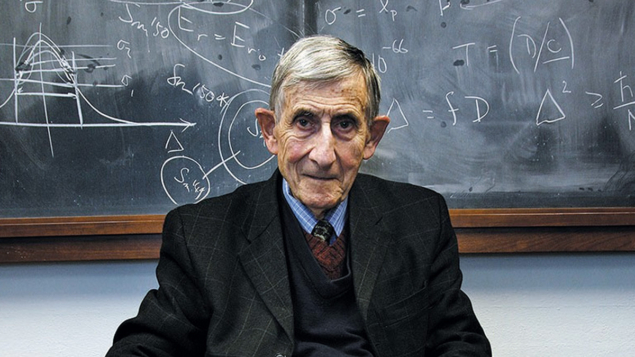“Well, Doc, You’re In”: Freeman Dyson’s Journey through the Universe, edited by David Kaiser, MIT Press

“Well, Doc, You’re In”: Freeman Dyson’s Journey through the Universe is a biographical account of an epochal theoretical physicist with a mind that was, by any measure, delightful and diverse. It portrays Dyson, a self-described frog among birds, as a one-off synthesis of blitz-spirit Britishness with American space-age can-do. Of the elite cadre of theoretical physicists who ushered in the era of quantum field theory, which dominates theoretical physics to this day, who else would have devoted so much time and sincere scientific energy to the development of a gargantuan spacecraft, powered by nuclear bombs periodically dropped beneath it, that would take human civilisation beyond our solar system!
Written by colleagues, friends, family members and selected experts, each chapter is more of a self-contained monograph, a link in a chain, than it is a portion of the continuous thread that one would find for a more traditional single-author biography. What is lost as a result of this format, such as an occasional repetition of key life moments, is more than sufficiently compensated by richness of perspective and a certain ease of pick-up put-down that comes from the narrational independence of the various chapters. If it has been a while since the reader last had a moment to pick it up, not much will be lost when one delves back in.
The early years of Dyson-caliber 20th-century theoretical physicists and mathematicians of his cohort are often interwoven with events surrounding the development of nuclear weapons or codebreaking. Dyson’s story as told in “Well, Doc, You’re In” stands apart in this respect, as he spent the war years working in Bomber Command for the Royal Air Force in England. His reflections on aspects of his own experience mirror, in some ways, the sentiments of future colleagues involved in the Manhattan project, noting: “Through science and technology, evil is organised bureaucratically so that no individual is responsible for what happens.”

The following years spent wrestling with quantum electrodynamics (QED) at Cornell make for lighter reading. The scattered remarks from eminent theorists such as Bethe and Oppenheimer on Dyson and his work, as well as from Dyson on his eminent colleagues, bring a sense of reality to the unfolding developments that would ultimately become a momentous leap forward in the understanding of quantum field theory.
“The preservation and fostering of diversity is the great goal that I would like to see embodied in our ethical principles and in our political actions,” said Dyson. Following his deep contributions to QED, Dyson embraced this spirit of diversity and jumped from scientific pond to pond in search of progress, be it the stability of matter or the properties of random matrices. It is interesting to learn, with hindsight, of the questions that gripped Dyson’s imagination at a time when particle physics was entering a golden era. As a reader one almost feels the contrarian spirit, or rebellion, in these choices as they are laid out against this backdrop.
Although scientifically Dyson may have been a frog, jumping from pond to pond, professionally he was anything but. Aged 29 he moved to the Institute for Advanced Study at Princeton and he stayed there to the end. In around 1960 Dyson joined the JASON defence advisory group, a group of scientists advising the US government on scientific matters. He remained a member until his passing in 2020. This consistent backdrop makes for a biographical story, which is essentially free from the distractions of the professional manoeuvring that typically punctuates biographies of great scientists. A positive consequence is that the various authors, and the reader, may focus that bit more keenly on the workings of Dyson’s mind.
For as long as graduate students learn quantum field theory, they will encounter Dyson. Sci-fi fans will recognise the Dyson Sphere (a structure surrounding a star to allow advanced civilisations to harvest more energy) featured in Star Trek, or note the name of the Orion III Spaceplane in 2001: A Space Odyssey. Dyson’s legacy is as vast and diverse as the world his mind explored and “Well, Doc, You’re In” is a fascinating glimpse within.





